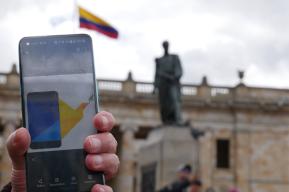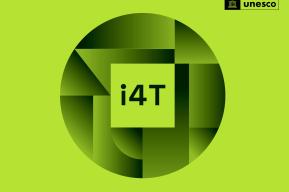Article
Judges and prosecutors trained in freedom of expression contribute to ending impunity for crimes against journalists

Judicial actors such as judges, lawyers, prosecutors and attorneys are key to breaking the cycle of violence against journalists and impunity for attacks. With their investigations and the jurisprudence of the Courts of Justice in favor of freedom of expression, they contribute to the application of the 3 Ps prevention, protection and prosecution of attacks, which help advance the Plan of Action for the Safety of Journalists and the Issue of Impunity.
The rate of unsolved cases of crimes against journalists has remained alarmingly high since UNESCO began collecting data. However, according to its latest report, there has been a gradual rise in resolved cases in the last ten years. This positive trend coincides with the establishment of the UN Plan of Action in 2012 and with the work that UNESCO has been carrying out since 2014 in training more than 24,000 judicial actors on international human rights standards in the field of press freedom, freedom of expression and right to information.
Regional Human Rights Courts, such as the Inter-American Court, are and will continue to be key players in achieving the goals of the UN Plan of Action, which on its tenth anniversary confirms its vital role in guaranteeing the rule of law and a fair environment. conducive to freedom of expression.
What is the role of judicial actors to end impunity for crimes against journalists and protect freedom of expression?
The justice systems have the duty to investigate with due diligence all crimes against journalists, in the understanding that when a journalist is attacked, not only is he or she attacked, but also the social group, since it undermines the right to public information, a fundamental pillar of democracy. In this sense, male and female judges, as well as prosecutors trained in the jurisprudence in defense of freedom of expression, substantially contribute to putting an end to impunity for crimes against journalists.
What do you consider to be the achievements in the last 10 years in terms of defending freedom of expression and the safety of journalists in the region?
From the Inter-American Court we have worked extensively on the development of a jurisprudence in defense of freedom of expression and for the safety of journalists. This jurisprudence is mandatory for all States party to the American Convention on Human Rights. In particular, the Judgment of the Case of Bedoya Lima and another v. Colombia is a great advance in the matter of jurisprudence in defense of the safety of journalists, as the Inter-American Court has established in the reparation measures the creation of a security fund for journalists that the State must always keep current. In turn, in this as in other judgments, the Court emphasized that the highest standards of effective protection against any type of violence against journalists in the region be maintained, and that includes specialized training for public officials.
In this sense, the alliance between UNESCO and the Inter-American Court of Human Rights, for the training of thousands and thousands of justice operators in recent years on jurisprudence on freedom of expression, has been a key tool in this process.
In the same way, with the support of UNESCO, the Inter-American Court has developed five editions of the Diploma in Human Rights for Journalists since 2010, so that communication professionals are aware of the tools at their disposal. to demand respect for freedom of expression.
How has the training of judicial actors in international standards on freedom of expression helped to achieve these achievements you mention and to put an end to impunity, improve the safety of journalists and protect freedom of expression?
Through the control of conventionality, judicial actors have an important role to play when applying the jurisprudence of international courts in the national sphere. Thanks to the training efforts for judges carried out by UNESCO with the support of the Inter-American Court, we have made substantial progress in the quantity and quality of information that judges have on freedom of expression and the safety of journalists.
Can we talk about common obstacles faced by legal systems in the region to address impunity for crimes against journalists? Can you mention an example?
The situation of violence against journalists has been changing as other spaces of threat against their work have been opened. In particular, there are two challenges that are seen in the different local realities of the practice of journalism: the growing criminalization of journalists for doing their job and, on the other hand, violence and digital harassment against women journalists. On the aspect of criminalization of journalists for doing their job, the Court has been expressing itself on different aspects. Regarding digital harassment against journalists, and particularly against women journalists, no cases have yet reached the Inter-American Court, but it is an alarming reality pointed out by various organizations that monitor the situation of freedom of journalists in the region.
In this sense, it is important that judges keep up to date with respect to the jurisprudential development of international courts and human rights standards regarding freedom of expression and safety of journalists. With more trained judges, as well as with journalists who are aware of the tools available to defend their work, we are making progress in creating more efficient protection schemes for freedom of expression.
How can the United Nations Plan of Action be an instrument to remove these obstacles and advance the protection of journalists in the years to come?
The United Nations Plan of Action to end impunity for crimes against journalists is a central tool to remove the obstacles that are generated to guarantee the safety of those who work in the media. One of the central aspects in this sense is the training of both male and female judges, as well as journalists. The Plan of Action is clear on this and the alliance developed between UNESCO and the Inter-American Court is an example in this regard. Thanks to this joint work space, thousands of judges receive training on the jurisprudence on freedom of expression and safety of journalists, and in turn, thousands of journalists have received training on this jurisprudence. With more trained judges and journalists, we have actors who know more about the Inter-American Human Rights System and therefore this jurisprudence can be applied and demanded in the national justice systems. This alliance between UNESCO and the Inter-American Court is a great opportunity to contribute to achieving Sustainable Development Goal 16 and we hope to continue working on the development of this Action Plan.
Ricardo Perez Manrique
President of the Inter-American Court of Human Rights, his current position, in the period 2022-2023. Lawyer from Uruguay, President of the Inter-American Court of Human Rights and Former Minister of the Supreme Court of Justice of the Oriental Republic of Uruguay.








